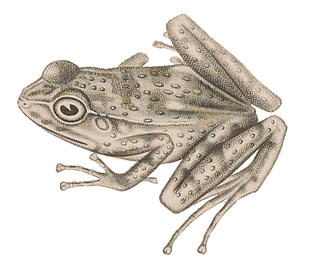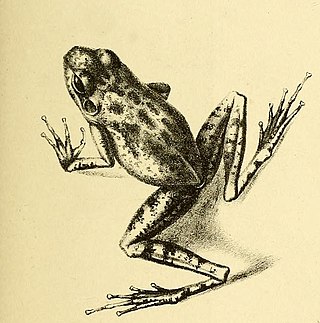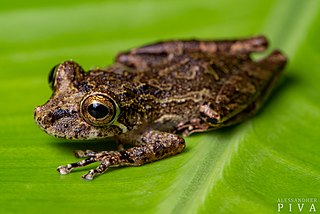
Physalaemus is a large genus of leptodactylid frogs. These frogs, sometimes known as dwarf frogs or foam frogs, are found in South America. It is very similar to Leptodactylus, a close relative, and indeed the recently described Leptodactylus lauramiriamae is in some aspects intermediate between them.
Phasmahyla guttata, the spotted leaf frog, is a species of frog in the subfamily Phyllomedusinae. It is endemic to Brazil. It lives in forests and near the edges of forests but not outside forests. It has been observed between 50 and 1200 meters above sea level.

Crossodactylus is a genus of frogs in the family Hylodidae. The genus occurs in Brazil, southern Paraguay, and northern Argentina. These frogs are sometimes known as Limnocharis, Tarsopterus, Calamobates, and by the common name spinythumb frogs. They typically inhabit streams in mountainous areas in the Atlantic Forest or in montane savanna.

Crossodactylus dantei or the Murici spinythumb frog, is a species of frog in the family Hylodidae. It is endemic to Brazil. Scientists know it exclusively from the type locality: Murici, in Alagoas. Its natural habitats are subtropical or tropical moist lowland forest and rivers. It is threatened by habitat loss.
Crossodactylus dispar is a species of frog in the family Hylodidae. It is endemic to Brazil. Its natural habitats are subtropical or tropical moist lowland forest, subtropical or tropical moist montane forest, and rivers. It is threatened by habitat loss.

Crossodactylus gaudichaudii is a species of frog in the family Hylodidae. The species is endemic to Brazil.
Crossodactylus grandis, or the Bahia spinythumb frog, is a species of frog in the family Hylodidae. It is endemic to Brazil. Its natural habitats are subtropical or tropical high-altitude grassland and rivers. It is known solely from the Parque Nacional do Itatiaia in Minas Gerais in Brazil, where it lives in cloud forests. It is threatened by habitat loss.
Crossodactylus lutzorum is a species of frog in the family Hylodidae. It is endemic to Brazil. Scientists know it exclusively from the type locality: Fazenda Água Branca in Bahia. Its natural habitats are subtropical or tropical moist lowland forest and rivers. It is threatened by habitat loss.
Crossodactylus schmidti or Schmidt's spinythumb frog is a species of frog in the family Hylodidae. It is found in Argentina, Brazil, and Paraguay. Its natural habitats are subtropical or tropical moist lowland forest and rivers. People have seen it between 300 and 750 meters above sea level. It is threatened by habitat loss.
Crossodactylus trachystomus is a species of frog in the family Hylodidae. It is endemic to the Espinhaço Mountains in Minas Gerais, Brazil.
Hylodes amnicola is a species of frog in the family Hylodidae. It is endemic to Minas Gerais in Brazil. It has been observed 1400 meters above sea level.

Hylodes nasus is a species of frog in the family Hylodidae. It is endemic to Brazil. Its natural habitats are subtropical or tropical moist lowland forest and rivers. This frog has been observed 1400 meters above sea level.

Phasmahyla spectabilis is a species of frog in the subfamily Phyllomedusinae. It is endemic to Brazil and known from the north-eastern Minas Gerais and adjacent southern Bahia. It occurs in fragments of Atlantic Forest at elevations of about 800 m (2,600 ft) above sea level.People have seen it as high as 850 meters above sea level.

Phyllodytes maculosus is a species of frogs in the family Hylidae endemic to Brazil's rainforests. It has been observed between 77 and 837 meters above sea level.

Ololygon is a genus of frogs in the family Hylidae. The majority of species in it are endemic to the Atlantic Forest of eastern Brazil, although the range of some species, including Ololygon aromothyella and Ololygon berthae, is known to extend south to northeastern Argentina, southern Paraguay, and Uruguay.
Scinax cosenzai is a species of frog in the family Hylidae. It is endemic to Brazil. People have seen it in the Parque Estadual da Serra do Brigadero in Minas Gerais.
Crossodactylus boulengeri is a species of frog in the family Hylodidae. It lives in the Serra do Mar mountain range in São Paulo and Rio de Janeiro in Brazil.
Crossodactylus franciscanus is a species of frog in the family Hylodidae. It is endemic to Brazil and has been observed at two sites, both in the state of Minas Gerais.
Crossodactylus timbuhy is a species of frog in the family Hylodidae. It is endemic to Brazil. It has been observed near Santa Teresa in Espírito Santo.
Crossodactylus werneri is a species of frog in the family Hylodidae. It is endemic to Brazil. It has been observed in parts of Serra da Mantiqueira stretching through Minas Gerais, Rio de Janeiro, and São Paulo.








